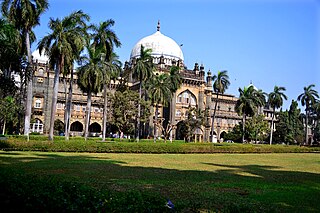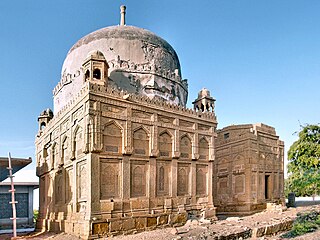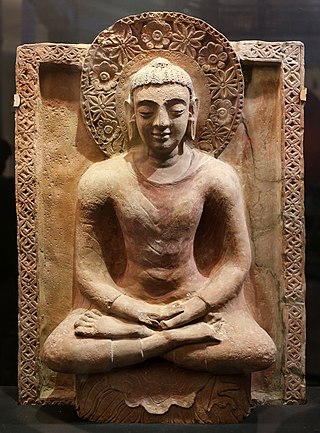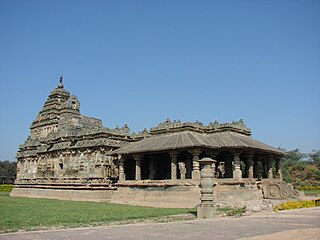
Chhatrapati Shivaji Maharaj Vastu Sangrahalaya, (CSMVS) originally named Prince of Wales Museum of Western India, is a museum in Mumbai (Bombay) which documents the history of India from prehistoric to modern times.

Mirpur Khas is the capital city of the Mirpur Khas District and Mirpur Khas Division in the Sindh province, Pakistan. Mirpur Khas is the 6th largest city in Sindh province and the 34th largest city of Pakistan. The city was built by Talpur rulers of Mankani branch. According to the 2017 Census of Pakistan, its population is 233,916. Mirpur Khas is known for its mango cultivation, with hundreds of varieties of the fruit produced each year - it is also called the “City of Mangoes,” and has been home to an annual mango festival since 1955. After the completion of Hyderabad-Mirpurkhas dual carriage way, the city has become hub of commercial activities.

The history of Sindh refers to the history of the modern-day Pakistani province of Sindh, as well as neighboring regions that periodically came under its sway.

The Sudarshana Chakra is a divine discus, attributed to Vishnu in the Hindu scriptures. The Sudarshana Chakra is generally portrayed on the right rear hand of the four hands of Vishnu, who also holds the Panchajanya (conch), the Kaumodaki (mace), and the Padma (lotus).

Pashupatinath Temple at Mandsaur, also referred to as the Mandsaur Shiva temple, is a Hindu temple dedicated to Lord Shiva in Mandsaur, Madhya Pradesh, India. It belongs to Pashupatinath tradition which is one of 6 major tradition within Shaivism. It is located on Shivna River, and is known for its eight-faced Shiva Linga. The temple sculpture is dated to the 5th or 6th century based on inscriptions, with some referring to the site as Dashapura. It is near the Rajasthan border in the historic region of Malwa, about 200 kilometres (120 mi) from Indore, about 340 kilometres (210 mi) west of Udaigiri Caves and about 220 kilometres (140 mi) east of Shamalaji ancient sites, both a significant source of Gupta Empire era archaeological discoveries. The site has been important to dating and the architectural studies of some distant sites such as the Elephanta Caves.

Kahu-Jo-Darro, also known as Mirpur Khas stupa, is an ancient Buddhist stupa found at the Mirpurkhas archaeological site in Sindh, Pakistan. The site is spread over 30 acres (120,000 m2). Excavations completed before 1910 revealed this large brick-based stupa and numerous terracotta reliefs now displayed in major world museums. The Mirpur Khas site is notable because historic Indian and Arab coins were found during its excavation. This has led scholars such as Derryl MacLean to suggest that Buddhism was thriving in Sindh region around the 10th-century and became extinct in these parts of the west and northwest South Asia after the Islamic conquest.

Vāsudeva, later incorporated as Vāsudeva-Krishna, Krishna-Vāsudeva or simply Krishna, was the son of Vasudeva Anakadundubhi, king of the Vrishnis in the region of Mathura. He was a leading member of the Vrishni heroes, and may well have been an historical ruler in the region of Mathura.

Hindu art encompasses the artistic traditions and styles culturally connected to Hinduism and have a long history of religious association with Hindu scriptures, rituals and worship.

The Sultanganj Buddha is a Gupta–Pala transitional period sculpture, the largest substantially complete copper Buddha figure known from the time. The statue is dated to between 500 and 700 AD. It is 2.3 m high and 1 m wide and weighs over 500 kg. It was found in the East Indian town of Sultanganj, Bhagalpur district, Bihar in 1861 during the construction of the East Indian Railway. It is now in the Birmingham Museum and Art Gallery, Birmingham, England.

Vaikuntha Chaturmurti or Vaikuntha Vishnu is a four-headed aspect of the Hindu god Vishnu, mostly found in Nepal and Kashmir. The icon represents Vishnu as the Supreme Being. He has a human head, a lion head, a boar head and a fierce head. Sometimes, even three-headed but aspects of Vishnu where the fierce rear head is dropped are considered to represent Vaikuntha Chaturmurti. Though iconographical treatises describe him to eight-armed, he is often depicted with four. Generally, Vaikuntha Chaturmurti is shown standing but sometimes he is depicted seated on his vahana (mount) Garuda.

The Brahma Jinalaya, sometimes called as the Greater Jain Temple of Lakkundi, is an early 11th-century Mahavira temple in Lakkundi, Gadag District of Karnataka state, India. The temple is attributed to Attiyabbe, the wife of the local governor Dandanayaka Nagadeva. It faces east, has a mukhamandapa, a gudhamandapa and its sanctum is covered by a sur-temple style vimana superstructure. The temple is notable for its reliefs depicting Jaina artwork, statues of the Tirthankaras and the two Hindu statues of Brahma and Saraswati inside its inner mandapa.

The Art of Mathura refers to a particular school of Indian art, almost entirely surviving in the form of sculpture, starting in the 2nd century BCE, which centered on the city of Mathura, in central northern India, during a period in which Buddhism, Jainism together with Hinduism flourished in India. Mathura "was the first artistic center to produce devotional icons for all the three faiths", and the pre-eminent center of religious artistic expression in India at least until the Gupta period, and was influential throughout the sub-continent.

The Kurkihar hoard is a set of 226 bronzes, mostly Buddhist, dating to between the 9th and 12th centuries CE, which were found in Kurkihar near Gaya in the Indian state of Bihar. The village of Kurkihar is situated about 5 km. north-east of Wazirganj, and 27 km east from Gaya. The inscriptions found suggest that Kurkihar was once a well known international pilgrimage center.

The Mora Well inscription is an ancient Sanskrit inscription found in the village of Mora about 7 miles (11 km) from Mathura, India. It is notable for its early mention of pratima (images), stone temple, and the Pancaviras.

Gupta art is the art of the Gupta Empire, which ruled most of northern India, with its peak between about 300 and 480 CE, surviving in much reduced form until c. 550. The Gupta period is generally regarded as a classic peak and golden age of North Indian art for all the major religious groups. Gupta art is characterized by its "Classical decorum", in contrast to the subsequent Indian medieval art, which "subordinated the figure to the larger religious purpose".

Kushan art, the art of the Kushan Empire in northern India, flourished between the 1st and the 4th century CE. It blended the traditions of the Greco-Buddhist art of Gandhara, influenced by Hellenistic artistic canons, and the more Indian art of Mathura. Kushan art follows the Hellenistic art of the Greco-Bactrian Kingdom as well as Indo-Greek art which had been flourishing between the 3rd century BCE and 1st century CE in Bactria and northwestern India, and the succeeding Indo-Scythian art. Before invading northern and central India and establishing themselves as a full-fledged empire, the Kushans had migrated from northwestern China and occupied for more than a century these Central Asian lands, where they are thought to have assimilated remnants of Greek populations, Greek culture, and Greek art, as well as the languages and scripts which they used in their coins and inscriptions: Greek and Bactrian, which they used together with the Indian Brahmi script.

Mudgarpani was a Yaksha deity in ancient India. His name means "Mudgar-holder", the Mudgar being an ancient form of heavy club, usually made of wood, but it can also be made of iron.

The Vrishni heroes, also referred to as Pancha-viras, are a group of five legendary, deified heroes who are found in the literature and archaeological sites of ancient India. Their earliest worship is attestable in the clan of the Vrishnis near Mathura by 4th-century BCE. Legends are associated with these deified heroes, some of which may be based on real, historical heroes of the Vrishni clan. Their early worship has been variously described as cross-sectarian, much like the cult of the Yakshas, related to the early Bhagavata tradition of Hinduism, and with possible links to Jainism as well. They and their legends – particularly of Krishna and Balarama – have been an important part of the Vaishnava tradition of Hinduism.
Vasudeva Sharan Agrawala, also Vasudeva Saran Agrawala, (1904–1966), was an Indian scholar of cultural history, Sanskrit and Hindi literature, numismatics, museology, and art history. He received the Sahitya Akademi Award in the Hindi language in 1956 for his prose commentary Padmavat Sanjivani Vyakhya. He was a professor in the Department of Art and Architecture at the Benares Hindu University.
Johanna Engelberta van Lohuizen-de Leeuw was a Dutch archaeologist and art historian, specializing in South and South-east Asia. Fluent in Sanskrit, she contributed important research to the study of antiquities in Afghanistan, Pakistan, India, and Sri Lanka, as well as in Thailand and Indonesia. Along with Raymond and Bridget Allchin, Jan van Lohuizen, and Harold Bailey, she founded the Ancient and Indian Iran Trust in Cambridge in 1978 to support historical and archaeological research in those regions, which later became a center of academic research in the field. She made notable contributions to the history of Kusana art. She was active in conservation efforts to preserve the archaeological sites of Indus Valley settlements at Mohenjo Daro, working with UNESCO for this purpose. She was also a photographer, and personally built an extensive collection of photographs of rare Asian artifacts, which is now housed in the University of Leiden.


















